 Netherlands Indies Paper Money Collection
Netherlands Indies Paper Money Collection Netherlands Indies Paper Money Collection
Netherlands Indies Paper Money Collection
| [ Last Update: Thursday, 30-Dec-2010 09:48:16 EST ] |
Government of Netherlands Indies | |
1943 Muntbiljetten Issue | |
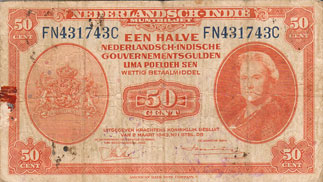 | P110 - 50 Cents Serial Number: FN431743C Front: Portrait of Queen Wilhelmina at right, arms at left, 02 March 1943 Back: Demonination Signatures: De Waarnemend Gouverneur Generaal van Nederlandsch-IndiŽ; De Javasche Bank, Directeur Secretaris Printer: American Bank Note Company. Size: 126 x 72 mm |
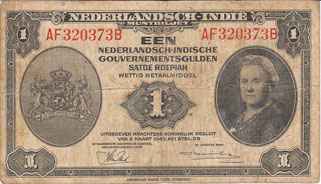 | P111 - 1 Gulden Serial Number: AF320373B Front: Portrait of Queen Wilhelmina at right, arms at left, 02 March 1943 Back: Signatures: De Waarnemend Gouverneur Generaal van Nederlandsch-IndiŽ; De Javasche Bank, Directeur Secretaris Printer: American Bank Note Company. Size: 125 x 72 mm |
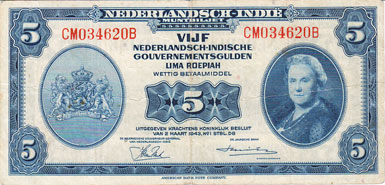 | P113 - 5 Gulden Serial Number: CMO34620B Front: Portrait of Queen Wilhelmina at right, arms at left, 02 March 1943 Back: Pilot standing next to an airplane, a fully equipped soldier, a warship Signatures: De Waarnemend Gouverneur Generaal van Nederlandsch-IndiŽ; De Javasche Bank, Directeur Secretaris Printer: American Bank Note Company. Size: 150 x 72 mm |
Japanese Occupation - World War II | |
De Japansche Regeering (The Japanese Government) | |
| After the fall of Singapore in February 1942, the Japanese attacked the Netherland Indies which were effectively overtaken by 9 March 1942 and held until surrender in August 1945. In 1942, the Japanese issued paper script currency of 1, 5 and 10 cents and ½, 1, 5 and 10 Gulden notes. What makes these notes unique are that they are written entirely in Dutch. Values are Een (1), Vijf (5) and Tien (10) cents and Guldens. All of these notes bear the following "De Japansche Regeering Betaalt Aan Toonder" or "The Japanese Government Promise To Pay The Bearer On Demand". Denominations of 100 and 1000 Roepiah were issued in 1944, with the Indonesian legend "Pemerintah Dai Nippon" (Japanese Government). An additional series, with denominations of ½, 1, 5, 10 and 100 Roepiah, was also issued in 1944 with the transliterated Japanese legend "Dai Nippon Teikoku Seiku" (Imperial Japanese Government). | |
1942 ND Issue | |
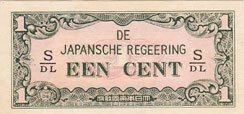 | P119b - 1 Cents Serial Number: Fractional S Prefix Front: Dutch text, "DE JAPANSCHE REGEERING EEN CENT" Back: Denomination and decorative designs Size: 95 x 45 mm |
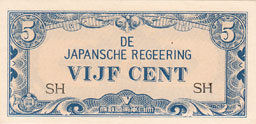 | P120b - 5 Cents Serial Number: SH Prefix Front: Dutch text, "DE JAPANSCHE REGEERING VLIF CENT" Back: Denomination and decorative designs Size: 100 x 48 mm |
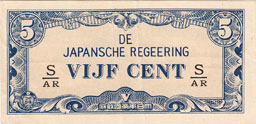 | P120c - 5 Cents Serial Number: Fractional S Prefix Front: Dutch text, "DE JAPANSCHE REGEERING VLIF CENT" Back: Denomination and decorative designs Size: 100 x 48 mm |
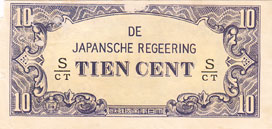 | P121c - 10 Cents Serial Number: Fractional S Prefix Front: Dutch text, "DE JAPANSCHE REGEERING TIEN CENT" Back: Denomination and decorative designs Size: 106 x 50 mm |
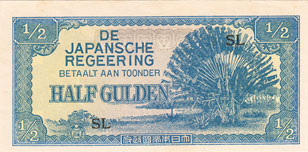 | P122b - ½ Gulden Serial Number: SL Prefix Front: Dutch text, "DE JAPANSCHE REGEERING BETAALT AAN TOONDER HALF GULDEN" (The Japanese Government Promise To Pay The Bearer On Demand ½ Gulden) Back: Denomination and decorative designs Size: 120 x 59 mm |
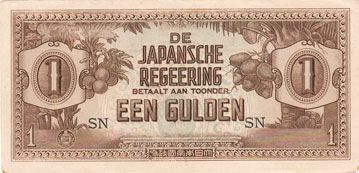 | P123c - 1 Gulden Serial Number: SN Prefix Front: Breadfruit tree at left, coconut palm tree at right, Dutch text, "DE JAPANSCHE REGEERING BETAALT AAN TOONDER" (The Japanese Government pays to the bearer) Back: Denomination and decorative designs Size: 140 x 67 mm |
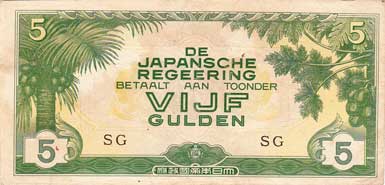 | P124 - 5 Gulden Serial Number: SG Prefix Front: Breadfruit tree at right, coconut palm tree at left, Dutch text, "DE JAPANSCHE REGEERING BETAALT AAN TOONDER" (The Japanese Government pays to the bearer) Back: Denomination and decorative designs Size: 150 x 72 mm |
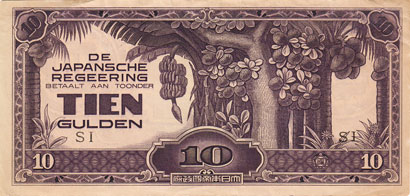 | P125c - 10 Gulden Serial Number: SI Prefix Front: Banana tree at center, coconut palm tree at right, Dutch text, "DE JAPANSCHE REGEERING BETAALT AAN TOONDER" (The Japanese Government pays to the bearer) Back: Plam trees with steamer ship in the background Size: 160 x 77 mm |
Dai Nippon Teikoku Seihu (Imperial Japanese Government) | |
1944 ND Issue | |
| A range of notes from Half Roepiah to 100 Roepiah was printed in Java after the Japanese occupation was well established and issued during 1944 under the authority of Dai Nippon Teikoku Seihu (The Imperial Japanese Government). | |
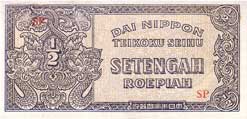 | P128 - ½ Roepiah Serial Number: SP Prefix Front: Stylized dragon with denomination at left Back: Size: 116 x 57 mm |
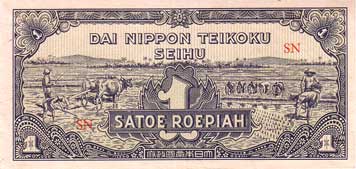 | P129 - 1 Roepiah Serial Number: SN Prefix Front: Planting rice in underprint Back: Banyan tree and temples of Dieng Plateau Size: 139 x 66 mm |
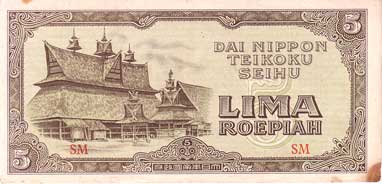 | P130 - 5 Roepiah Serial Number: SM Prefix Front: Batak house at left Back: Batak woman (Sumatera) at center Size: 149 x 72 mm |
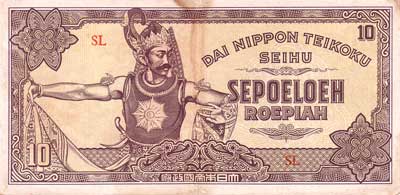 | P131 - 10 Roepiah Serial Number: SL Prefix Front: Javanese dancer at left Back: Stupas and statues of Buddha from Borobudur Temple at left and right Size: 156 x 76 mm |
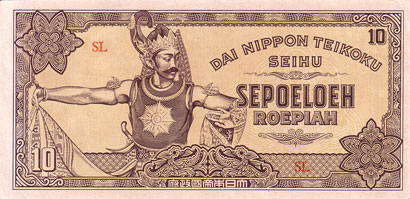 | P-131a - 10 Roepiah, 1944 (No date printed on the note) Front: Image of Ghatotkacha, a character in the Mahabharata epic and the son of Bhima and the giantess Hidimbi (sister of Hidimba). His maternal parentage made him half-Rakshasa (giant), and gave him many magical powers that made him an important fighter in the Kurukshetra war, the climax of the epic. Back: Images of Bhudda and stupas at left and right Size: 160 x 77 mm |
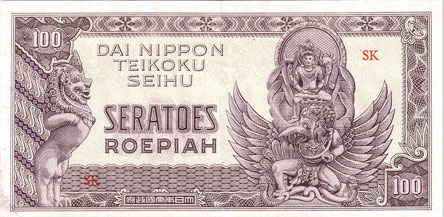 | P-133 - 100 Roepiah Issued: 1943 (No date printed on the note) Front: Image depicting the Garuda Whisnu Kencana statue, the largest statue in Bali. Designed and built by Nyoman Nuarta, one of Indonesia's foremost modern sculptor, the Garuda Wisnu Kencana statue or GWK and its pedestal building will be standing 150 meters tall with its wings span 64 meters across. Made from more than 4000 tons of copper and brass, the statue is picturing Lord Wisnu, as the source of wisdom, riding on the back of the mythical bird Garuda as the manifestation of conscience toward Amerta, the perennial goodness. Back: Image depicting Arjuna as a wayang (Javanese puppet play) prominent figure. Arjuan is one of the Pandavas, the heroes of the Hindu epic Mahabharata. Arjuna, whose name means 'bright', 'shining', 'white' or 'silver' (cf. Latin argentum), was such a peerless archer that he is often referred to as Jishnu - the undefeatable. Size: 175 x 86 mm |
De Javasche Bank | |
| De Javasche Bank (DJB) was established in 1828. The financial condition in Dutch Indies was considered in need of orderliness and payment system regulation through a bank institution. Simultaneously the business people in Batavia, Dutch Indies had spurred the urgency for the establishment of a bank institution to fulfill their business requirements. However, the idea was materialized only when King Willem the first issued a Power of Attorney to the General Commissioner of Dutch Indies on 9 December 1826. This letter authorized the Dutch Indies Administration to set up a bank pursuant to the special authority with a definite period or commonly known as the Exclusive Rights (Octrooi)
With such power, the Dutch Indies Administration began to prepare for the establishment of DJB. On 11 December 1827, the General Commissioner of Dutch Indies, Leonard Pierre Joseph Burggraaf Du Bus de Gisignies issued Decree No. 28 regarding the Exclusive Rights and the provisions regarding DJB. Subsequently, on 24 January 1828 through the Decree of the General Commissioner of Dutch Indies No. 25, the Deed of Incorporation of De Javasche Bank (DJB) was stipulated. Simultaneously, Mr. C de Haan was appointed President DJB and C.J. Smulders Secretary of DJB. | |
1933-1939 Issue | |
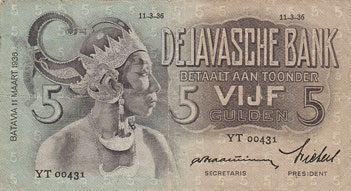 | P78a - 5 Gulden Serial Number: YY 00431 Front: Javanese dancer at left, issue date in top center and top right Back: Text at lower left in Javanese and Arabic, text at lower right in Dutch and Chinese Printer: Joh. Enschede en Zonen, Netherlands Size: 137 x 75 mm |
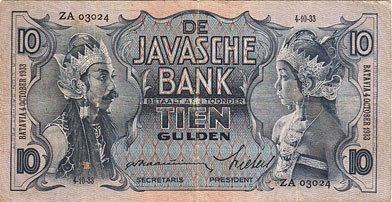 | P79a - 10 Gulden Serial Number: ZA 03024 Front: Javanese dancers at left and right, issue date at lower left top right Back: Text at lower left in Javanese and Arabic, text at lower right in Dutch and Chinese Printer: Joh. Enschede en Zonen, Netherlands Size: 153 x 80 mm |
1946 Issue | |
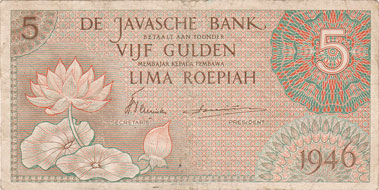 | P88 - 5 Gulden Serial Number: DBY 028036 Front: Lotus at left, issue date in lower right corner Back: Text in four boxes in Dutch, Javanese, Chinese, and Arabic Size: 148 x 74 mm |
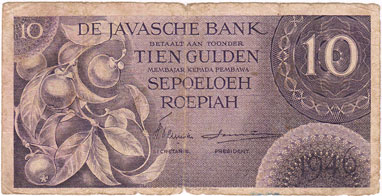 | P90 - 10 Gulden Serial Number: JHA 085759 Front: Mangosteens at left, issue date in lower right corner Back: Text in four boxes in Dutch, Javanese, Chinese, and Arabic Size: 149 x 75 mm |
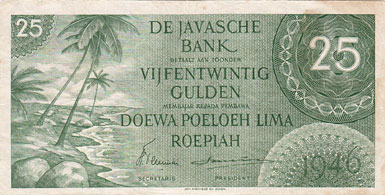 | P91 - 25 Gulden Serial Number: NLV 004733 Front: Beach with palm trees at left, issue date in lower right corner Back: Text in four boxes in Dutch, Javanese, Chinese, and Arabic Size: 150 x 75 mm |
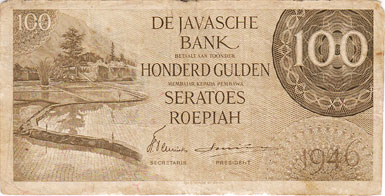 | P94 - 100 Gulden Serial Number: STG 053271 Front: Rice fields and mountains at left, issue date in lower right corner Back: Text in four boxes in Dutch, Javanese, Chinese, and Arabic Size: 150 x 75 mm |
1948 Issue | |
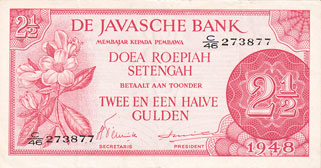 | P99 - 2½ Gulden Serial Number: C/46 273877 Front: Flowers at left, issue date in lower right corner Back: Text in two boxes in Dutch and Indonesian Size: 125 x 65 mm |